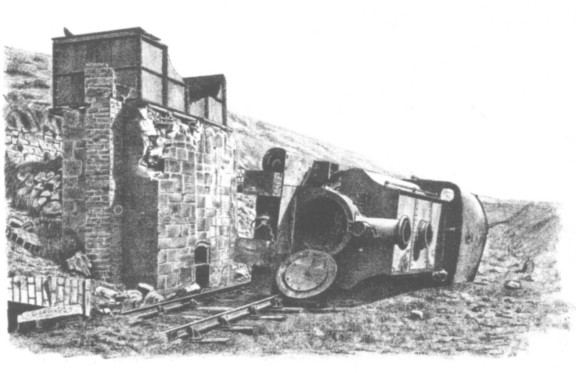
| THE INDUSTRIAL RAILWAY RECORD |
© JUNE 1971 |
EXPLOSION ON THE FORDELL RAILWAY
"The locomotive ‘Alice’, the boiler of which exploded, was the property of the trustees of the late Mr Mercer Henderson, of Fordel, Fifeshire, the certificated manager of whose collieries is Mr Robert Muir Morton, Fordel Collieries, Crossgates, Fife. … It was employed on their private line to draw trucks from the pit heads to the small shipping port of St David’s, in Inverkeithing Bay. Mr Mercer Henderson, of Fordel, and his trustees have for a long period been in use to work their own minerals, and we think it right to say that their management has been so careful that this is the first accident that has been reported in connection with their mineral workings… The boiler [of ‘Alice’] was ... 12 ft.4 ins. in length by 3 ft.71/8 ins. in diameter. It was .. built by Messrs Grant, Ritchie & Co. of Kilmarnock, in 1880. . .

"From May 1895 to the new year of 1896 the engine worked without any symptoms of weakness, but at the latter date the engine-driver complained of a slight escape of steam… On 13th April 1896, she ran down to St David’s with a full train, and was in course of bringing up a load of 24 empty trucks – not a heavy load. Near Hillend Bridge she stopped to take in water at the water-tank. There were riding on the engine besides the engine-driver, Drysdale, and the stoker, George, also Mr Morton himself, and an elderly man, Duncan, the School Board officer of the district who was taking the advantage of a lift up the hill. Providentially Mr Morton and Drysdale got off the engine to go a little distance from the line to examine a water meter, for while they were absent the explosion took place. George, the stoker, who was engaged with the hose for filling the tank, was thrown to a considerable distance, and so injured that he died on the following day. Duncan, though rendered insensible, escaped with only minor injuries. The engine was lifted from the rails by the force of the explosion and thrown over on its side. At the time of the explosion [about 1.15 pm] the pressure was not under 115 lbs, probably 118 lbs, and it may have risen a point or two while the engine was standing, though it was not blowing off. On subsequent examination the cause of the accident was clearly seen to be grooving in the line of the two tapped rivet-holes, extending for a considerable distance along the line of the junction of the plates."

(The above information has been extracted from Boiler Explosion Report No.949, issued by the Board of Trade, and is the second such Report to appear in the RECORD, (For the first see page 254 of RECORD 30.) In subsequent issues we intend to feature more of these Reports which in some instances contain copious details of industrial locomotives and railways. The Boiler Explosion Acts, 1882 (45 and 46 Vic, c.22) and 1890 (53 and 54 Vic, c.35) provide for inquiry into boiler explosions, the 1890 Act making the 1882 Act applicable to sea and mine boilers. Within 24 hours of a boiler explosion, the Board of Trade has to be informed by the owner, user, or person acting for him. From our point of view this must be adjudged one of the more enlightened pieces of legislation to which Queen Victoria gave her assent – KPP)
"The locomotives of the United States would constitute, if coupled together, a train of solid iron and steel 300 miles long." ("lron" 23rd December 1892 – KPP)
"The output of the Baldwin Locomotive Works in 1892 was 670 engines, 210 of this number being Vauclain compounds. The number of engines built at these works in 1891 was 899." ("Iron", 20th January 1893. – KPP)
"The French Government has placed an order with the Baldwin Locomotive Works for 100 locomotives. The design of these engines is based on what is known as the Pechot type, which is a modification of the Fairlie system. Quick delivery is specified for this order, which was secured through the London office of the Baldwin Company." ("The Locomotive Magazine", 15th March 1915. – KPP)
"The British Government, which ordered some time back fifty Consolidation and seventy-five Prairie type locomotives from the Baldwin Locomotive Works, has recently placed with that Company an additional order for 100 Consolidation locomotives. Orders have also been placed by the United States Government for 300 80−ton Consolidation locomotives for service in France, 150 of which are to be built by the American Locomotive Company and 150 by the Baldwin Works."
("The Locomotive Magazine" 15th September 1917. – KPP)